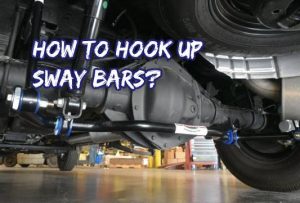 A sway bar, or in other words, a stabilizer bar, is a U-shaped bar that goes between the front pair of wheels or between the rear pair of wheels of the vehicle. This bar is made of steel; it is extremely sturdy but not overly stiff. The job of the sway bar is to reduce the leaning in turns that you experience when the car turns sharp corners.
A sway bar, or in other words, a stabilizer bar, is a U-shaped bar that goes between the front pair of wheels or between the rear pair of wheels of the vehicle. This bar is made of steel; it is extremely sturdy but not overly stiff. The job of the sway bar is to reduce the leaning in turns that you experience when the car turns sharp corners.
The sway bars stabilize the vehicle during these sharp cuts by using the suspension components on each side. Without it, your car will still be able to make sharp turns, but the turns will feel more ‘risky.’ With it, you will be able to turn corners much more swiftly.
And in this article, we’ll talk about how to hook up sway bars. Let’s begin.
Installation Process
Now, let’s talk about the installation. This component of the car, as we said, has to be installed to the front-to-front or the rear-to-rear wheel. As claimed by the RoyalMechanic, the location of installation will have a definite impact on the car. Nevertheless, we have provided a step-by-step guide for your convenience. If you follow this properly, the installation should be really easy for you.
Step 1: Get the right sway bar for your vehicle
There are loads to choose from, and they differ in terms of particular hitches and weights.
Step 2: Get in your car and go on a test drive at normal speeds
Pay attention to the trailer so that you can locate where the tension screws are. Once those are located, turn them ¼ inches to increase or decrease the tension as you feel is necessary, going by the results of that test drive you just took.
Step 3: Choose the location for installation
Install the sway bar near the hitch ball but make sure that you install it 1.5 inches forward and 5.5 inches outward from the hitch ball. Keep the bar centered all the while during installation.
Step 4: Now attach the handle to the desired location
Rub some grease onto the handle’s threads so that it works very smoothly without any resistance.
Step 5: Measure the distance of sway bar and the car body
Measure the distance from the sway bar to the body of the car, and it’s right if it’s about 4.5 inches. Make sure that the bar is parallel to the body, and then tighten the bolts to attach the coupler of the bar to the hitch ball.
Step 6: Drill holes through the bracket and the frame.
Drive the rivets through each of the holes by using a hammer, and voila, you’re done.
Now when you’re on the go, it’s normal for you to feel the sway bars need a little adjusting.
This might happen because of the weight on the vehicle, or it might happen because the suspension gets used up and needs to be fixed again.
If that happens, just stop the vehicle and get down to the job. It’s better to check and be safe than to be sorry.
When this happens, you’ll already know whether your bar needs to be loosened or tightened. So, use that sense to make the right call. If you do the opposite of what is required, then a simple test drive will lay it out to you again. This is not that tricky a case, after all.
Know When The Sway Bar Needs Changing
If readjusting the sway bar still doesn’t fix the problem, then you might need to change the bar entirely. You will know whether the bar is the problem if you face the following issues with it. Constant clunking noises, rattling sounds, instability while driving, the car going a bit awry while it makes turns.
Conclusion:
Don’t leave a problematic sway bar in the car because that will affect the suspension of your car in the long run. This is especially true for areas that have wet roads. If you are taking turns with a damaged sway bar, your car might skid too much, and that will be quite hazardous if you’re going on high speeds.
And now that you’ve learned how to hook up sway bars, it shouldn’t be a problem for you. Let us know if you need anything else.